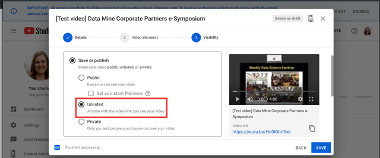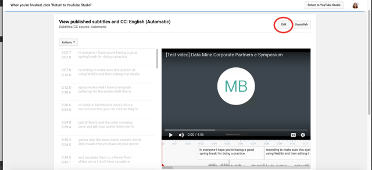Video Deliverables
CONTENT STILL UNDER CONSTRUCTION FOR SPRING 2024.
|
These posters and videos will be shared publicly during the Symposium. It is essential that students Work closely with their Corporate Partner Mentor to identify what parts of the project can be publicly shared without violating any NDAs. The Data Mine will send all posters to review the company’s legal team before posting for the Symposium. |
3 Minute Thesis
The video presentation will follow the format of the 3 Minute This (3MT).
Think of the 3MT as an elevator pitch for your project. Imagine you just came out of lab, you walk into an elevator, and someone joins you and asks, "What class are you getting out of?" You say Data Mine lab, and this person asks, "Oh, tell me about the work you’re doing." You have just 180 seconds to explain the complex research and project work your team has completed since the beginning of the term. AND this person likely does not have a technical background.
That’s the whole idea of the 3 Minute Thesis (3MT), to succinctly describe a research topic in a way that engages the listener and leaves them with a better understanding of: The Why – why is this research important? The What – what is the relevant background information? The Impact – how does this connect back to the average person or greater society?
Guidelines for the 3MT
-
You must use a single static PowerPoint slide with no transitions or animations.
-
You cannot use your poster as the slide.
-
-
You are limited to 3 minutes maximum.
-
2 minutes minimum.
-
-
Presentations are to be spoken word (e.g. no poems, raps or songs)
Where did The Three Minute Thesis (3MT®) come from?
The Three Minute Thesis is an annual public speaking competition at many universities, inviting researchers to succinctly articulate the impact and breadth of their research within a 3-minute timeframe, targeting a non-specialist audience. Originating from the University of Queensland in 2008, this innovative contest has rapidly expanded its reach, now captivating audiences in over 85 countries worldwide!
Learn more about the origins of 3MT: link
Expectations
All students must contribute to the 3MT, but likely in different roles.
-
Here are some examples of different roles the students can fill(as well as added suggestions):
-
One or more students can brainstorm ideas and bring together the storytelling presentation components. (See "How to Write a Winning 3MT Script" below)
-
One student can assemble the single PowerPoint slide to be used. It is recommended that you add visuals to your slide and limit text. (See "How to design and impactful 3MT slide" below)
-
One or more students can write the script for the 3MT. (See "How to Write a Winning 3MT Script" below)
-
Make sure to practice reading it to ensure it fits within the required time.
-
-
One or two students can create the video recording and voice over.
-
One student can do any necessary video editing and add the closed captions. Work closely with your Corporate Partner Mentor to identify what parts of the project can be publicly shared.
-
The Data Mine will send all videos to review the company’s legal team before posting for the Symposium
-
Due Dates
|
Drafts of the poster and video due Wednesday, March 6, 2024. Final versions of the poster and video due Wednesday, April 3, 2024. |
A submitted 3MT video draft includes:
-
1 slide
-
1 written script
-
1 initial video recording. Captioning not required for the draft. TAs will submit the drafts (one per team).
Script Guidelines
-
Use an attention-grabbing hook to engage your audience from the start.
-
Implement storytelling using the ABT (And, But, Therefore) template.
-
Try tools like analogies, humor, and characters to enhance engagement.
-
Eliminate technical jargon to ensure clarity for all listeners.
-
Conclude your story by bringing it full circle (back to the hook), leaving a lasting impression on your audience
Slide Guidelines
-
Cannot use your poster as a slide.
-
Consider simple graphs and data - consider it a graphical abstract that represents the project.
-
Opt for eye-catching images, creating your own if necessary.
-
Minimize text to convey key points succinctly.
-
Embrace negative space, allowing for visual balance and emphasis on essential elements.
Video Guidelines
-
The 3MT video doesn’t have to include everything you did all year long, but it should discuss the motivation for the project.
-
Any necessary background (keep it brief), and your results.
-
Think of this as a “movie trailer” or “elevator pitch” for your Q&A and discussion at the Symposium.
-
Length aware between 2 - 3 minutes
Record your video
There are a variety of ways to create your video recording. Here are some options:
-
Record audio for each slide and export the PowerPoint as a video.
-
This works exceptionally well and is very simple. If you have an app demonstration, you can use a screen recording tool above to make two separate videos (PowerPoint and demo) or stitch them together in an editor.
-
-
Record your entire screen or selected portion of your screen on your Mac.
-
Record your screen in Windows 10.
-
Record using OBS Studio which is free for Windows, Mac, and Linux
-
Record using Apowersoft which is an in-browser tool for free
-
Record your screen on your iPad.
-
[Only recommended if multiple people will be talking in the video and option 1 above does not seem to work] Share your screen and record in Zoom. purdue-edu.zoom.us/
Upload your video
-
Go to youtube.com and click on the Camera > Upload Video. You have to be signed into your account.
 Figure 1. Screenshot of uploading a video in YouTube.
Figure 1. Screenshot of uploading a video in YouTube. -
Upload your video. There are lots of tutorials online on how to upload a video to YouTube. The most important part is to make your video Unlisted so it is not searchable.
 Figure 2. Screenshot of listing video as
Figure 2. Screenshot of listing video as
Add ADA Closed Captions
-
You are required to add closed captioning to your video on YouTube.
-
CC’s should be added to the draft and final video
-
YouTube will automatically generate Closed Captions which makes this step easy. However, you MUST edit them for punctuation, capitalization, and any spelling or interpretation errors.
-
This link is a great resource with tutorials on how to add and edit automatic captions on YouTube.
-
Below is an example of the auto captions that were generated for a test video. Click Edit to add punctuation and make changes.

ADA Closed Caption Guidelines
-
Include no more than 32 characters per line.
-
One to three lines of text appear onscreen, display for three to seven seconds, and then are replaced by the next caption.
-
Captions are available throughout the entire video, even when there is no speaking.
-
Time captions to synchronize with the audio.
-
Require the use of upper and lowercase letters.
-
Use a font similar to Helvetica medium.
-
Captions should be accessible and readily available to those who need or want them.
-
Captions should appear onscreen long enough to be read.
-
Speakers should be identified when more than one person is onscreen or when the speaker is not visible.
-
Spelling is correct.
-
Words should be verbatim when time allows or as close as possible in other situations.
-
All words are captioned, regardless of language or dialect.
-
Punctuation is used to clarify meaning.
-
Add music or other descriptions inside brackets such as [music] or [laughter].
-
Indicate when no narration is present and describe any relevant sound effects.
-
Use of slang and accent is preserved and identified.
Rubric
The video rubric follows the same criteria as the poster rubric. In addition, The video rubric includes criteria about the speaker, the flow, and closed captioning. Video slides should be mostly bullet points and figures. Students should be speaking about the details of the project, not just read from the slides.
| Category | Needs Significant Improvement (60%) | Needs Improvement (75%) | Meets Expectations (90%) | Exceeds Expectations (100%) |
|---|---|---|---|---|
Description of research purpose, conclusions, outcomes, and impact of project work (15 points) |
The team did not provide details about the research purpose, conclusions, outcomes, and impact of project work |
The team provides minimal detail on their research purpose, conclusions, outcomes, and impact of project work. |
The team provides great details about research purpose, conclusions, outcomes, and impact of project work. |
The team provides an easy-to-understand and thorough description of research purpose, conclusions, outcomes, and impact of project work. |
Description of research strategy/design and the results/findings (15 points) |
The team did not provide details about the research strategy/design and the results/findings. |
The results are unclear. The team didn’t explain how the research strategy/design and the results/findings were used. |
The team mentions the research strategy/design and the results/findings of the project. Details may be unclear. |
The team provides precise details on the research strategy/design and the results/findings of the project. |
Ideas logically built each other and examples used (15 points) |
Ideas presented are not easy to follow and no examples were used. |
Ideas presented are able to be followed, but confusing. Examples were used, but not effectively. |
Ideas presented are good and related to the project. Examples were effectively used to tell the story of the project work. |
Ideas presented are compelling and built an easy-to-follow story of the project work. Examples are intriguing and enhance listeners' understanding. |
Background information in an engaging meaningful manner (15 points) |
Key terms were not defined, and background information confusing. |
Key terms were not defined, and background information was not provided where useful. |
Key terms were defined, and background information was provided where useful. |
Key terms were defined, and background information was provided where useful in a way that was engaging and memorable. |
Presented using non-technical language (10 points) |
Unclear or confusing way to explain the research in jargon-free language appropriate to a non-specialist audience. |
The presenter did not explain the research in jargon-free language appropriate to a non-specialist audience. |
The presenter explained the research in jargon-free language appropriate to a non-specialist audience. |
The presenter explained the research in jargon-free language appropriate to a non-specialist audience in a way that was engaging and memorable. |
Use of one PowerPoint slide (5 points) |
Did not use a single PowerPoint slide. |
The PowerPoint slide did not seem to be related to the project work at all. |
The PowerPoint slide is professionally done and easy to understand how it connects to the project work. |
The PowerPoint slide enhances the story of the project work effectively and captivates the audience. |
Use of storytelling elements including an intriguing opener, analogies, and closure to bring the story full circle (15 points) |
The presentation lacks storytelling elements and design that attract the audience. |
The presentation is poorly designed, confusing, and distracting. Topics are hard to follow, and the work doesn’t appear professional. |
The presentation is professionally done and easy to understand. Flow and storytelling elements need slight improvements. |
The presentation is well thought out and compelling. It’s easy to follow and understand quickly. |
ADA Closed Caption Guidelines (10 points) |
Closed captions are not included in the video. |
Closed captions are present but do not adhere to ADA guidelines. |
Closed captions adhere to most ADA guidelines but may need minor adjustments. |
Closed captions adhere to ADA guidelines. |
Note: Captioning not required for the draft so drafts will be graded on overall completeness.